AUTONOMOUS PLANETARY LANDER PROJECT
Equinox has initiated the Safe, Autonomous Intelligent
Landed Sample Return (SAILSaR) project.
Equinox Interscience, Inc. has assembled a core group
of talented individuals and companies with plans to produce
a new generation of Autonomous Planetary Landing Craft,
Rovers, and Sample Return Vehicles. Their purpose is to
deliver scientific instrumentation where needed safely,
even in rugged terrain.
The landers will provide power, control, and data
handling for science users, and will ultimately return
samples off of the surface. Equinox also offers instrument
design, development and integration services for the
science investigators.
Companies/institutions contributing to the effort to
date include Equinox Interscience in the leading role,
along with ITN Energy Systems, Global Solar, Blueline
Engineering, Environmental Aeroscience Corporation,
Aeroventions Corp. and Performance Software Associates.
"Our flight systems will be applicable to missions
to the moon, Mars, asteroids, Europa, and other solar
system destinations," said Dan Scheld, Vice President
of Engineering. The Equinox craft will feature hazard
avoidance landing technology to increase mission assurance.
The initial development program has been identified as the
Safe, Autonomous, Intelligent Landed Sample Return program,
or SAILSaR. Prototype landers will be dropped by balloon
and C130 aircraft into rugged terrain in Utah, the Arctic
and other specially selected Mars analog environments.
This Slide Show
presents additional technical details of the SAILSaR design
concept. Watch this web site for further updates.
EQUINOX
AUTONOMOUS PLANETARY LANDER FOR MARS
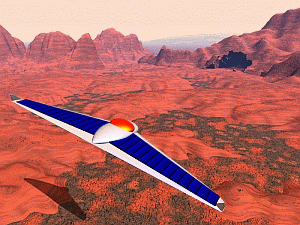
|
| Mother Goose Flying Wing Over Mars |
|---|
The first major project of the Equinox
Interscience, Inc. Autonomous Planetary Project has been
to develop a flight system concept in response to the NASA
request for mission concepts for the Mars Scout program.
Equinox serves as the lead technical organization with Dr.
P. J. Boston, P.I. for the
Mother Goose Mission
Proposal.
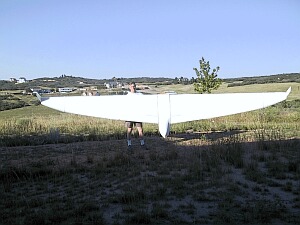 |
Jay Fullinwider with mockup of
21 foot glider.
|
|---|
Equinox, Aeroventions Corp. and Performance Software Associates
Inc., continue to pursue development of the Mars Glider
concept. A flight demonstration of the
second in a series of subscale models with 8-foot wing span
was performed on June 1, 2002.
The third subscale model with a 12-foot wingspan was completed and
tested October 2002. Work is now proceeding on a 4th model with
a 21-foot wing span with first flight tests planned for August 2003.
An article highlighting our Mars Glider project appeared June 12, 2002
on space.com.
See
SPACE.COM article about Mars Glider
Here is a series of photos showing the
Evolution of Mother Goose Mars Glider concept.
Glider Movie: (AVI 1.7mb),
(Quicktime, MOV 2.2mb)
The Mother Goose Mission Concept was presented at the Mars Society
Conference, Aug 10, 2002:
Presentation:
(PowerPoint 15.6mb)
Glider Movie 2: (Quicktime
22mb),
(Quicktime
50.5mb)
Other product lines and special
telescope projects:
TRACKERs
ASTRONOMICAL PROJECTS
IMAGERs/SCENE PROJECTION
RESEARCH INSTRUMENTS
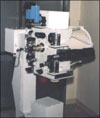
TRACKERs
The Space Based Laser Fire Control Testbed
- Acquires, tracks and illuminates missiles
- 36-cm cassegrain optics
- Surrurier truss
- 2-axis gimbal
- Direct drive DC torque motors
- Nd: YAG &HeNe lasers
- IR acquisition camera
- CCD scoring camera
- Illuminator beam point ahead
- Risley prism point ahead mechanism
- Track rates up to 10 deg/s
- Acceleration rates up to 90 deg/s
SBLFC Customers
- Lockheed Martin
- BMDO
- USAF
ASTRONOMICAL PROJECTS
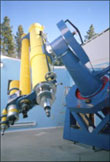 The Luyten Observatory Twin Refractor
The Luyten Observatory Twin Refractor
- Main Instrument 36-cm, F/10.0 apochromat
- Guide Telescope 25-cm, F/13.5 achromat
- 20-cm, F/5.0 astrograph
- Extended polar axis astrographic equatorial mount
- Roller drives: 1.1-m and 80-cm final drive wheels
- Analog and digital setting circles
- Total mass 3250-Kg, Moving Mass 1900-Kg
Luyten Observatory customers
- Equinox demonstration and test facility
The University of Denver (DU)
Student Astronomy Lab (SAL) Project
SAL Customers
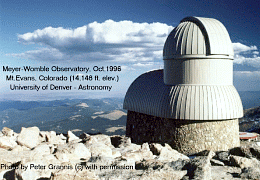
DU Observatory Projects
Equinox is under contract to provide services to DU
observatories
IMAGERs/SCENE PROJECTION
Digital Imaging Panoramic Sensor (DIPS)
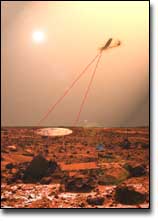
- 360 degree panoramic azimuth coverage
- Real time (5-30fps) operation
- Color imaging
- Rugged construction for mobile use
Dips Customers
- Proposed to Pathfinder Systems, Inc.
PLANETARY IMAGERS
- Mars Raptor Recon System (MRRS)
- Hummingbird/Discovery
RESEARCH INSTRUMENTS
PULSED TUBE COOLER (PTCs)
PRODUCTS NEW!-
See our site for updates
MINERAL IDENTIFICATION
AND COMPOSITION ANALYZER
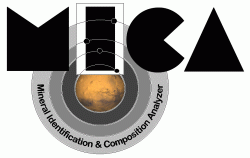
The Mineral Identification and Composition
Analyzer (MICA) will demonstrate the feasibility of
a miniaturized tool for in-situ X-Ray Diffraction (XRD),
X-Ray Fluorescence (XRF), and optical imaging on unprepared
samples.
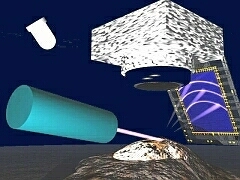 |
Mineral Identification and
Composition Analyzer
(MICA) |
|---|
MICA will automatically
perform these non-destructive analyses to quickly determine
the geological nature of samples, image the crystalline
structure and appearance, and measure the elemental
content. MICA data will be useful for analysis of
regolith and rocks encountered during exploration of an
extraterrestrial surface, and selection of unique and
interesting samples for return to Earth. MICA
requires no sample acquisition or preparation; only that
the sample be in contact with the instrument.
The planned activities include a three-year project to
design, develop, fabricate, and test a brassboard
MICA instrument, ready for simulated Mars rover tests.
MICA has been selected for development
under NASA's Mars Instrument Development Project (MIDP).
MICA Home
Page
SPELEOSCOPE
INSTRUMENT FOR INVESTIGATION OF
MICROBIAL MATS
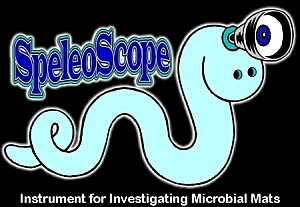
There have been recent discoveries and
characterizations of dense, microbial mats up to several
centimeters thick that line the narrow and twisting
interior rock architecture of highly active
hydrogen-sulfide and carbon monoxide emitting springs
located in a carbonate cave (Cueva de Villa Luz) in
Tabasco, Mexico. Within the lava tube caves, the best
chance for discovery of life processes in hostile
environments is in these water fillled winding rock
"micropassages".
 |
| Speleoscope Instrument
Head |
|---|
Locating and cataloging similar features on Mars would
be of value in the search for water, the search for signs
of life, and in helping to determine past climatic
conditions on Mars. Many of the critical questions
regarding the environment, potential for water, potential
for life (past/present), etc. are not currently accessible
to study because we simply cannot reach in for in-situ
sensing and imaging and we cannot retrieve samples.
SPELEOSCOPE addresses this need with a flexible,
threadable, sterilized thin probe. Mounted to a Rover or
Rover Arm, the probe in its simplest incarnation would be
fitted with an imager, gas sensors, and an ion selective
microelectrode protected by an abrasion barrier. More
elaborate versions will include the ability to aseptically
"microsample" the mineralogical and biological
material that may be present.
A project is proposed by Equinox Interscience Inc (EI)
teamed with Dr. Penelope Boston as PI to design, build, and
test an instrument for use in earth caves that will provide
valuable information about living forms in non-typical
environments, generally considered hostile to life, a goal
of the
Astrobiology program. The proposed instrument will
specifically address the issue of accessing and making
measurements in these aqueous micropassages in earth caves
with the goal of later modifying the instrument for
non-aqueous earth micropassages and for Mars.
SPELEOSCOPE is a candidate for NASAs
Astrobiology Science & Technology Instrument
Development Program (ASTID).
 SPELEOSCOPE Home Page
SPELEOSCOPE Home Page
Feel Free to contact us to discuss
your system and application needs.
WE ARE HERE TO HELP!
|

